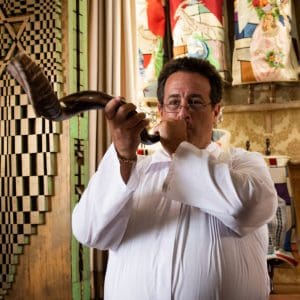Torah Commentary with Rabbi Laurence Rosenthal
Parshat Metzora
Leviticus 14:1-15:33
Seeing the Metzora
By Rabbi Laurence Rosenthal

There is an unusual sentence at the beginning of this week's sidra which is drawing my attention. In Leviticus Chapter 14, we learn about the encounter of the metzora, a person with a scaly skin condition which has required quarantine outside the encampment of Israel, with the priest who is acting as the clinician. Our parsha opens at the end of the quarantine period and after healing has occurred. We are told that the Cohen goes out of the camp to examine the individual in question. The Torah makes some assumptions about this person's condition. The text begins by telling us,
זֹאת תִּהְיֶה תּוֹרַת הַמְּצֹרָע בְּיוֹם טָהֳרָתוֹ וְהוּבָא אֶל־הַכֹּהֵן:
"This is the Torah (lit: teaching) of the metzora in the day of their purification, and when they are brought to the Cohen" (Leviticus 14:2).
Interestingly, the next verse states that this 'teaching of the metzora's purification' is predicated on the Priest seeing that healing has occurred. I find it noteworthy to point out that if this was truly the day of their purification, wouldn't the examination (the "seeing") already have taken place? Meaning, if the priest didn't find the infection to have cleared then presumably the metzora would have returned to quarantine. More important is the discrepancy between verse 2 and verse 3:
וְיָצָא הַכֹּהֵן אֶל־מִחוּץ לַמַּחֲנֶה וְרָאָה הַכֹּהֵן וְהִנֵּה נִרְפָּא נֶגַע־הַצָּרַעַת מִן־הַצָּרוּעַ:
"The Cohen goes outside the encampment and the Cohen sees and behold, the one who is afflicted with the infection was healed from the infection" (Leviticus 14:3).
In verse 2 it states that the metzora is brought to the Cohen and in Verse 3 is appears that the Cohen goes to the metzora who has been waiting outside the camp. Finally, we get to the sentence that I am branding unusual:
וְצִוָּה הַכֹּהֵן וְלָקַח לַמִּטַּהֵר
"And the Cohen commanded and he took for the one to be purified" (Leviticus 14:4).
What am I finding unusual about this sentence structure? Firstly, although we have learned a lot about the work of the Cohen, I don't remember the Cohen "commanding." The term "tziva" (related to the word, Mitzvah) is usually reserve for God. However, it appears that the Cohen is not only being instructive he is doing so aggressively, "the Cohen commands." Next, it isn't clear what the Cohen is commanding or who the Cohen is commanding. The inclusion of the letter "vav" with the next word "lekakh – and he took," seems to indicate what the Cohen did next, not necessarily what the Cohen commanded others to do. And to drive this point even further, the patient's new title, "the one to be purified," has the prefix letter of lamed which means "for," indicating that the birds which will be offered later in the verse are to be taken "for" the one who is to be purified, not from. This is all to say that it remains unclear who is being commanded and what exactly that commandment is in this case.
The remainder of the verse and subsequent verses share ritual instructions which are familiar to the many chapters and instructions that have preceded this verse throughout the book of Leviticus. So why and what is the priest commanding? I imagine that the priest must speak boldly and commend others on behalf of the exiled because others might be hesitant to let them back in. The Torah states that the metzora is to be brought to the Cohen but eventually, the Cohen needed to get up and go out to the metzora. Why wasn't the metzora brought to the Cohen as instructed by the Torah? Was there nobody willing to escort the metzora to the Cohen? Have the barriers of the community become so impenetrable that the Cohen needed to go out because the metzora couldn't gain access? Additionally, it's telling that the Cohen changes the person's title from metzora (afflicted one) to metaheir (purified one).
Since I am not a dermatologist, these verses speak to my spiritual life slightly differently, but the challenges are still the same. As one of the leaders of our community, I am ever mindful of those who have been "sent out" of the community and the work that needs to be done to bring them back in. Sometime the exile is specific to an individual – a death, a divorce, an unfortunate legal misstep, a political disagreement. For those cases, time often will help fade away the community's recollection and bias allowing those individuals clearer passage back into community. Other times, the reason or exile is more insidious and is steeped in cultural bias, fear, and bigotry – homosexuality, non-binary, and transgender people, Jews of color, intermarried, people who convert, to name a few. These situations require us to boldly state what these individuals mean to us as a community – they are Jews and we must embrace and bring them into our community. The metzora in these cases afflicts the eyes and mind of those keeping them out and not as a stain on those being kept outside the camp. It's important that we do as our Cohanim did, venture outside the camp, see them, really see them, and call them by a new name, one that is loving, caring and humanizing.






























